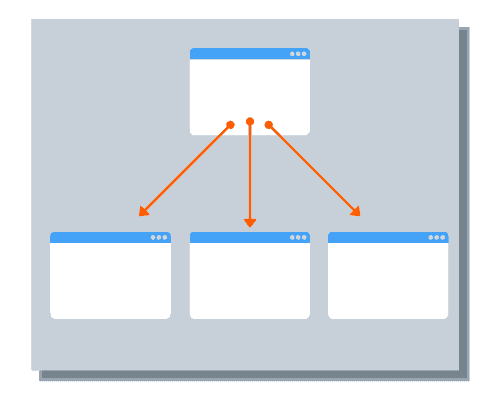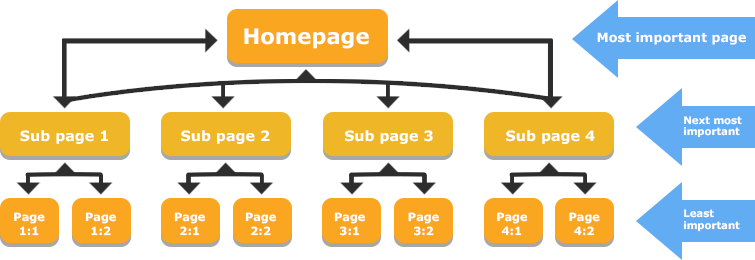Do you include internal links in your SEO strategy?
If you’re a business owner, you know that SEO is important for bringing organic traffic from search engines. And one essential part of any good SEO strategy is internal links.
By linking to other pages on your website, you can help improve your website’s ranking in search results and make it easier for visitors to find the information they need. This blog post will discuss why internal linking is essential for SEO and how to use it effectively.
Internal links are an essential part of SEO because they help pass link juice from one page to another, which can help improve your rankings in search engines. They also help keep people on your website longer, boosting your bounce rate and improving your overall SEO score.
The image below demonstrates what a internal link does

What are internal links and why are they important for SEO purposes?
Internal links are links that connect one page of a website to another page within the same domain. These links are essential for SEO because they direct a user’s focus, help websites acquire higher visibility in search engine rankings, and allow users to navigate through various pages quickly.
Additionally, internal links assist crawler robots from search engines like Google as they index webpages and allow them to evaluate how two pages are related to each other.
When internal linking is done correctly it can increase website traffic and establish an easier path for all visitors navigating between different web pages.
Overall, using internal links properly allows websites to ensure their content is seen and taken advantage of by potential customers.
Here are 5 reasons why you should be using internal links in your SEO strategy:
Increase Page Authority
Internal links help to increase the authority of a page by creating connections between other pages on the same website. Which can help improve its ranking in search engine results.
Improve User Experience
Internal links provide a more convenient way for visitors to find the information they need, which can lead to longer website visits and improved engagement.
Improve Your Crawlability
Internal links allow crawlers to understand how webpages are related, which can help boost your overall ranking in search results.
Make Suggestions
Including internal links on relevant pages can create a better user experience by suggesting other relevant content that might appeal to visitors.
Create Structure
Internal links help to structure your website and make it easier for users to find what they need.
Internal linking is an important part of any successful SEO strategy, so it’s important to use them effectively and strategically.
This will help increase your website’s visibility, boost engagement, and create better user experiences.

Tips for creating effective internal links that will help your SEO efforts?
When it comes to SEO, a vital component of any successful strategy is effective internal link building.
Internal links play an essential role in helping search engines find and rank your site, so it’s important to take the proper steps when creating them.
To maximise your SEO efforts with internal linking, use keyword anchors when possible and make links that are more than just words; aim for phrases that accurately describe what the target page is about so the end user knows what to expect.
Additionally, create internal contextual links wherever applicable, providing additional link value rather than simply having all your links as embedded URLs.
Finally, keep track of broken or duplicate internal links by running comprehensive audits regularly using tools like SEMrush.
What is anchor text in SEO?
Anchor text is the clickable text of a link, usually highlighted in blue and underlined to indicate that you can click on it to navigate to another page within the website.
Anchor text is used in SEO to help search engines better understand a link’s context and how it relates to other pages within your website.
When used correctly, anchor text can help improve the relevance of a page for specific keywords or topics. Additionally, it is recommended by Google to use descriptive anchor text that accurately reflects the content being linked to – this will make it easier for users to identify what they are clicking on and result in a better overall user experience.
By making sure your internal links are optimised with anchor text, you can help boost your website’s rankings in major search engines.

How many links should be on your website, and where is the best place to put them?
Adding internal links to your website can be highly beneficial as they help make navigating easier for visitors and promote longer stay times.
But it’s essential to avoid overdoing it – too many internal links can lead to a cluttered look, making it hard for users to find what they are looking for.
Google says you should aim for two or three internal links on each website page.
Additionally, the best place to include these links is usually within the body content – but if you’d like them to get noticed more easily by users, try adding them as anchor text in buttons or images.
What is the difference between internal and external links?
What are internal links in seo?
Internal links are those that point to another page on the same website. They help visitors navigate between different parts of the website and can often be used as a way to signal relevance for specific topics.
internal linking structure

What are external links?
They are links to other websites outside of your own domain. These can be used to improve the credibility of your website and can even help boost its rankings if they come from authoritative websites.
These types of links are essential for SEO but should be used sparingly – too many external links can overwhelm users, so it’s best to use them judiciously.
Internal linking vs external links
The critical dissimilarity between internal and external links is that internal links point to another page within the same website. External links direct users to a page on an entirely different website.
Internal links are used to help visitors navigate through your website more efficiently, as well as help search engine crawlers understand how pages are related.
What are nofollow links?
Nofollow links are HTML tags that tell search engines not to follow a specific link.
It is usually used when linking to untrusted content or when website owners do not want search engine bots to index the linked page.
Internal links are often left without nofollow tags; this is where internal links become an essential part of a successful SEO strategy.
Pro Tip: not all content you may want on google follow this guide on how to remove old content from google

Conclusion
Internal links are a powerful SEO tool that can help you rank higher in search engine results, drive traffic to important pages on your website, and boost the engagement and usability of your site.
Now is the time to start if you’re not using internal links in your SEO strategy. Not sure where to begin?
Get in touch and find out how our SEO services can help you grow your revenue.
Do internal links count as backlinks?
No internal links do not count as backlinks, but they are still crucial to your SEO strategy. Internal links are links that point to other pages on the same website.
They provide both users and search engine crawlers with a way of navigating through the site structure and content, making it more user-friendly and helping Google understand what each page is about.
What qualifies as a backlink?
A backlink is an external link which points to your website from another domain. Backlinks are essential for SEO, as they show Google that your content has been recommended by other websites and is worthy of ranking higher in the SERPs. So only a link from a site other than your own site classes as a backlink.
Are internal links a ranking factor?
Though internal links aren’t a direct ranking factor in Google’s algorithm, they are still important for SEO.
What are dofollow internal links?
Dofollow internal links are links that pass on “link juice” and help to increase the PageRank of individual pages on your website. In other words, they are a ranking signal to search engines like Google, telling them which pages are most important and should be given priority in the SERPs (google search results).
Does internal linking improve domain authority?
Yes, internal linking does help improve a website’s domain authority. For example, linking different pages on the same webpage helps create an interconnected web of content, which search engine crawlers can explore and index more easily. This, in turn, improves the overall domain authority of your website.
